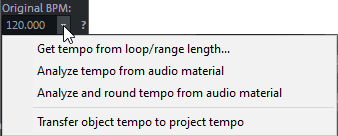Time/Pitch

Timestretch/Pitchshift
In this view, objects can be changed in pitch (pitch shifting) and tempo (time stretching). Except in "Resampling" mode, this can be done simultaneously and independently.
The upper knob controls the pitch shifting (Pitchshifting). You can also enter the pitch change in the fields Pitch in semitones and cents or as Pitch factor relative to the initial value.
If you move the mouse over the field Pitch, you can set the pitch change in 10 cent steps with the mouse wheel, in cent steps with Ctrl + mouse wheel and in semitone steps with Shift + mouse wheel.
The lower knob controls the tempo change (Timestretching). You can also enter the tempo change in the fields Stretch Length as a length change or Stretch Factor as a relative factor to the initial value, or enter the desired tempo in BPM (Beats Per Minute).
To calculate the stretch factor from the BPM input, the original tempo is needed.
|
|
A question mark next to the entry field indicates that the displayed value is a default value and may not correct. |
You can either enter the original tempo manually or let the program calculate it. To do this, click on the arrow next to the value.

-
Get tempo from loop/range length: A range section above the object is used to calculate tempo. Select the option and enter how many quarter notes should be included in the selection.
-
Analyze tempo from audio material: Melodyne will calculate the tempo. Melodyne must be installed for this. More on this at Melodyne integration.
-
Analyze and round off tempo from audio material: The calculated tempo will be rounded off to a whole BPM value.
-
Transfer object tempo to project tempo: The calculated object tempo is used as project tempo.
Mode: Four algorithms may be used for realtime time stretching and pitch shifting: élastique Pro, élastique Efficient, Resample and Monophonic Voice.
The button Edit opens an extended display of the timestretching/pitchshifting parameters.
Read more about the algorithms and the advanced parameters at Resampling/Timestretching/Pitchshifting in the Effects section.
The Elastic Audio button opens the selected object in the Elastic Audio editor.
Use musical tempo adjustment: adjusts the playback tempo of the object to the project tempo (tempo map). For more information, see the section Musical Tempo Adjustment
Loop
Here you will find the settings for looping objects. For more information, see section Looping objects.
